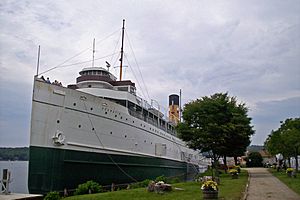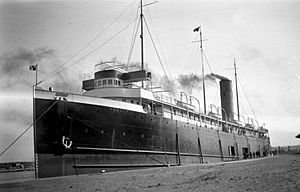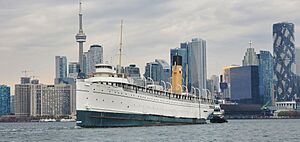SS Keewatin facts for kids

Keewatin alongside in Douglas
|
|
Quick facts for kids History |
|
|---|---|
| Name | Keewatin |
| Owner | Canadian Pacific Steamship Company |
| Port of registry | |
| Builder | Fairfield Shipbuilding and Engineering Company, Govan, Scotland |
| Launched | 6 July 1907 |
| Christened | 1907 |
| Maiden voyage | 14 September 1907 |
| In service | 7 October 1908 |
| Out of service | 29 November 1965 |
| Status | Museum ship |
| General characteristics | |
| Type | Passenger liner |
| Tonnage | 3,856 GRT |
| Length | 102.6 m (336 ft 7 in) pp |
| Beam | 13.3 m (43 ft 8 in) |
| Draught | 23 ft 7 in (7.2 m) |
| Installed power | 3,000 hp (2,200 kW) nominal |
| Propulsion |
|
| Speed | 16 knots (30 km/h; 18 mph) max |
| Capacity | 288 |
| Crew | 86 |
The SS Keewatin is a historic passenger liner that once sailed the Great Lakes in Canada. This amazing ship carried people and goods between Thunder Bay (then Port Arthur/Fort William) on Lake Superior and Port McNicoll on Georgian Bay (Lake Huron). It was part of the Canadian Pacific Railway's important shipping service.
The Keewatin is special because it's one of the largest remaining passenger steamers from the Edwardian era. This means it was built around the time King Edward VII ruled, over 100 years ago! Only a few other ships like it, such as the Nomadic and the TSS Earnslaw, are still around today.
Contents
About the SS Keewatin Ship
The Keewatin is a type of ship called a passenger liner. When it was built, it weighed about 3,856 gross tons. The ship is about 102.6 meters (336 feet) long and 13.3 meters (43 feet) wide. It also has a depth of about 7.19 meters (23 feet 7 inches) below the water.
How the Keewatin Sailed
The ship was powered by four large scotch boilers that burned coal. These boilers created steam for a special steam engine called a quadruple expansion engine. This engine turned a single screw at the back of the ship, giving it about 3,000 horsepower. This power allowed the Keewatin to reach a top speed of 16 knots (about 30 kilometers per hour). Its usual cruising speed was 14 knots.
Passenger and Crew Capacity
The Keewatin was designed to carry many people. It had 108 rooms for passengers, with beds for up to 288 travelers. The ship also needed a large team to operate it safely. There were 86 officers and crew members working on board.
Building and Service History
The Keewatin was built in Govan, Glasgow, Scotland, by the Fairfield Shipbuilding and Engineering Company. It was launched into the water on July 6, 1907, and finished being built in September of that year.
Journey to the Great Lakes
The ship's first journey was quite unusual. It sailed to Lévis, Quebec, where it had to be cut in half! This was because the canals, especially the Welland Canal, were not wide enough for such a long ship to pass through. After being cut, the two halves were moved to Buffalo, New York, where they were put back together. The Keewatin then continued its journey on its own power. It began its regular service from Owen Sound, Ontario, on October 7, 1908.
Keewatin's Main Route
The Keewatin was built to help connect the Canadian Pacific Railway's train lines across Canada. It worked alongside its sister ship Assiniboia and three other ships: Manitoba, Athabaska, and Alberta. These ships linked the railway's station in Owen Sound to Fort William Port Arthur on Lake Superior.
In 1912, Port McNicoll, Ontario, became the new main port for these ships. The journey between ports took about two and a half days, including time to pass through the Soo Locks. Port McNicoll became a busy hub, sometimes called the "Chicago of the North." However, when the Trans Canada Highway was completed in 1965, people started traveling more by car. This led to the end of the train and ship services, and Port McNicoll became much quieter.
End of Passenger Service
In its later years, the Keewatin and Assiniboia had to follow strict safety rules. These rules were put in place after a big ship fire in 1949. In 1950, the Keewatin had a sprinkler system and fire walls installed. Its wooden masts were also replaced with steel ones.
Even with these changes, the ships' wooden cabins and upper structures made them less safe than newer ships. As more people chose faster ways to travel, the demand for overnight passenger ships on the Great Lakes decreased. To keep sailing after 1965, the ships would have needed major rebuilding of their wooden parts. So, they stopped carrying passengers. The Keewatin made its last passenger trip on November 29, 1965.
The next year, the Keewatin carried only freight. On November 8, 1966, it was sold to a company for demolition. Its sister ship, Assiniboia, stopped service in 1967 and was later destroyed by fire in 1969. The Keewatin and Assiniboia were among the last of the old-style overnight passenger ships on the Great Lakes.
Keewatin as a Museum Ship
Instead of being scrapped, the Keewatin was bought in January 1967 by Roland J. Peterson Sr., a businessman from Michigan. He paid $37,000 for it, which was more than its scrap value. The ship arrived in Douglas, Michigan, on the Kalamazoo River, on June 27, 1967.
From 1968, the ship was known as the Keewatin Maritime Museum. It was permanently docked in Douglas, across the river from Saugatuck, Michigan, until 2012.
Moving the Keewatin Back Home
In July 2011, it was announced that the Keewatin had been sold to Skyline Marine. The ship was carefully moved from the Kalamazoo River on June 4, 2012. This required digging a long, deep, and wide channel to get it to Lake Michigan. With a crew of ten, the Keewatin was then towed back to Canada. It arrived back in its old home port of Port McNicoll on June 23, 2012.
This move was possible thanks to the help of local, provincial, and federal officials. They helped get the necessary permits to dredge the harbor where the Keewatin had sat for 45 years. A special foundation, the Diane and RJ Peterson Keewatin Foundation, was created to run the ship and restore it.
On June 23, 2012, a celebration marked the Keewatins return. It was exactly 45 years after the ship left Port McNicoll in 1967, and 100 years after it first started working from that same dock in 1912.
In late 2017, there were talks about moving the Keewatin to Midland, Ontario. However, by March 2018, it was decided the ship would stay in Port McNicoll for another summer. In 2019, a development company planned to keep the Keewatin as a museum in a park. But by June 2020, the owner, Skyline Investments, decided to donate the ship to the Marine Museum of the Great Lakes in Kingston. The museum officially took ownership of the Keewatin in March 2023.
The Keewatin left Port McNicoll on April 24, 2023, after weeks of preparation by volunteers. It arrived at Heddle Shipyards in Hamilton Harbour on April 29, 2023, for repairs. The ship then arrived in Kingston on October 26, 2023, towed by tugboats. It was placed in a dry dock and given a special heritage designation. The Keewatin opened for public tours on May 17, 2024.
Keewatin in Film and TV
The Keewatin has been used as a set for many documentaries and TV shows about ships. It has stood in for famous ships like the Lusitania, the Yarmouth Castle, Canadian Pacific's Empress of Ireland, and even the Titanic. It was also featured in the first episode of Season Seven of the TV show Murdoch Mysteries, called "Murdoch Ahoy". A documentary about saving the Keewatin, titled "Bring Her on Home: The Return of S.S. Keewatin", was shown on CBC Canada.



